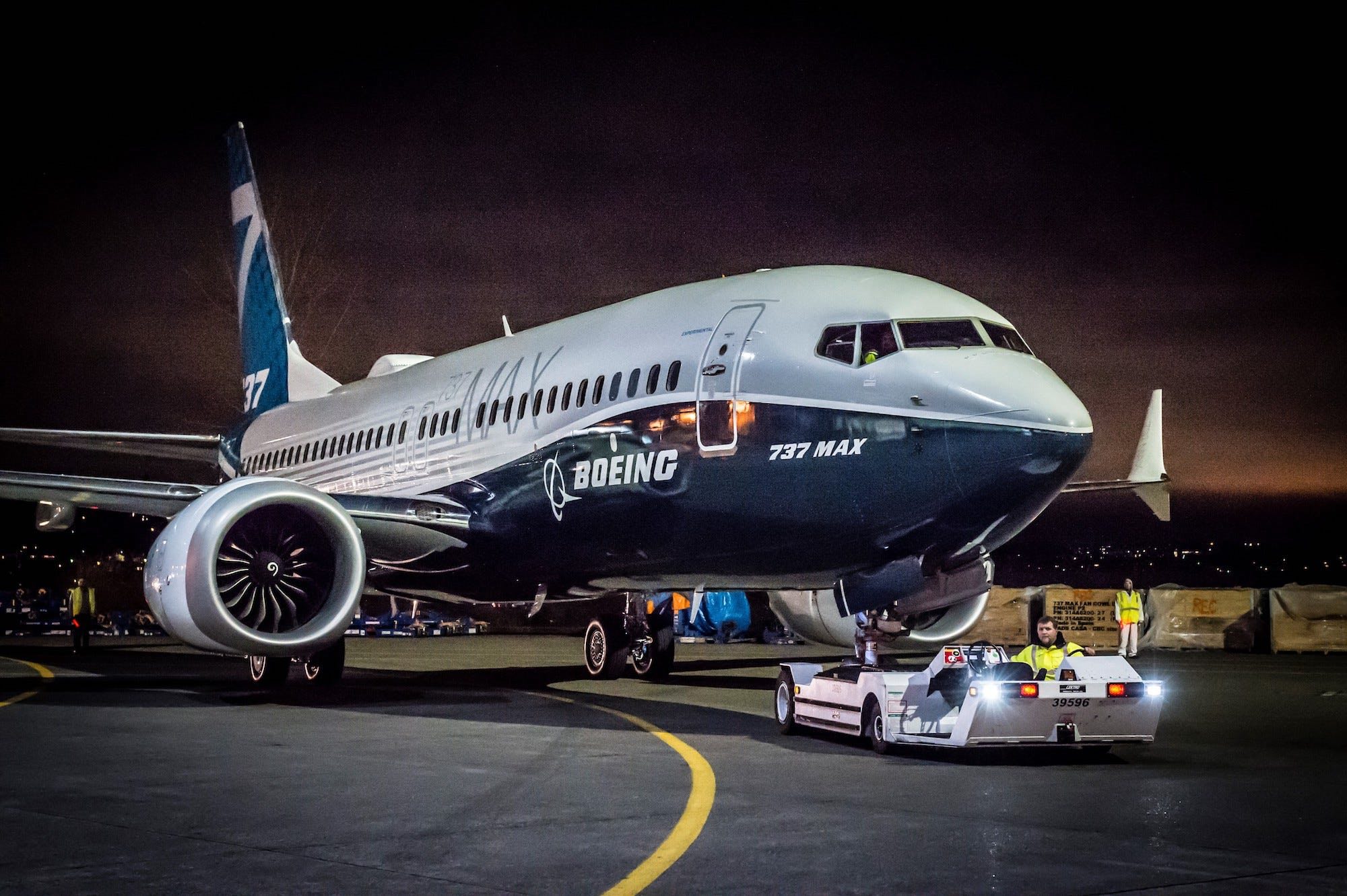What Boeing hoped would be an isolated problem has turned into a widespread issue and another safety and credibility concern.
Last week, I reported that Boeing discovered fuel debris during spot inspections of undelivered 737 MAXs. Even though the MAXs have sat idle since last spring, they still require routine maintenance to remain airworthy.
Boeing responded to this unanticipated discovery by embarking upon a thorough examination of all of its undelivered 737 MAX aircraft for fuel debris. Hoping it would not find widespread debris, the opposite has occurred. Already, Boeing found debris in 35 aircraft, 70% of the 50 jets that have been inspected so far.
Boeing has about 400 MAX aircraft waiting to be delivered.
A Boeing spokesperson told the Wall Street Journal, “Boeing is taking it very, very seriously.” Boeing has expanded its debris inspection beyond the fuel tanks to other parts of the airplane.
It also issued a strongly-worded statement seeking to ensure customers the problem would be swiftly dealt with:
“This is unacceptable and won’t be tolerated on any Boeing aircraft when it’s delivered to the customer.”
Boeing stresses the inspections are voluntary and the issue was disclosed voluntarily. While both points are true, Boeing misses the point.
Boeing supposedly had advanced software, including logging each tool in and out, precisely to prevent against debris. It has stringent guidelines and checklists intended to eliminate any such debris. The widespread debris makes it reasonable to wonder what other lapses may have occurred in safety and quality control checks.
Fuel debris can include metal shavings, tools, and other objects left behind during assembly. While there is likely no link between the fuel tank debris and the two 737 MAX crashes, the news once again demonstrates that Boeing has seemingly cut many corners. Plus, this debris may increase the risk of electrical short-circuiting and fires.
CONCLUSION
The 737 MAX has remained grounded for nearly a year, after a pair of crashes killed 346 people. As Boeing continues to promise a “software fix” is just around the corner, it must grapple with a more sinister reality: it has forfeited much of its trust that a software update will not overcome.
It could be that the 70% ratio does not continue for the remaining 350 MAXs that will soon be inspected. But isn’t 35 aircraft with debris 35 aircraft too many?
image: Boeing





It obviously means workers were lying while logging their tools. Sounds like some should be fired.
More importantly what about the already delivered aircraft?
This program needs to hire a safety czar with powerful authority to punish people. But it’s stock price hasn’t tanked. Goes to show the market things the politicians will still coddle the company.
I’m reminded of the USSR East German Trabant: Yes, it was terribly made but they flew off the shelves (so to speak) because Soviet consumers had little other choice. Either get one or walk. If the USSR had sold stock in Trabant in 1970, I’d have bought it.
Even though the 737 Max is mostly a product of trying to keep up with Airbus, Boeing is nonetheless seemingly guaranteed revenue for decades to come. I don’t think Airbus has the capacity to produce all the world’s passenger jets and worldwide passenger air traffic continues to skyrocket.
We’ll have to see how this plays out. When Southwest says they have a route available, non stop but you gotta get on a 737 max or you can pay more to fly some smaller regional jet with 1 or more stops in twice the time, will you go for it?
Consumers sent the message to airline CEO’s loud and clear when Spirit profits soared despite a product of uncomfortable seats, no amenities, and irregular operations. Take it, or leave it.
737-ToolShed
Certainly this is a item of serious concern but it doesn’t personally diminish my trust in Boeing products. Why? Because Boeing found the issue, is taking swift and appropriate action to address it, and is inspecting all affected aircraft to ensure that they are FOD free.
What would have diminished my trust in Boeing is if they were trying to sweep this under the rug or describe it as a one off or limited problem. Fortunately they are doing none of the above.
That being said from a PR perspective it’s clearly another black eye that they did not need.
And had these aircraft been delivered with the debris in tact would that have diminished your trust in Boeing which seems to be unllimited?
Had the 7M8 not been grounded for almost a year Boeing would not have inspected these aircraft and who knows, you might have been flying one when debris got in the fuel lines.
I’ll stick to Airbus and in Europe that’s easy. Quite simply, if it’s a Boeing, I’m not going.
121Pilot, you are wasting your digital breath here. The self-appointed aviation safety experts are just an ignorant mob that doesn’t care about facts or understanding anything beyond their little keyboards. They want scalps and clicks. Nothing that you or any other highly-trained professional says will make any difference. Because they Know Stuff.
Another one who is longing to fly with fuel lines clogged with debris.
I can understand one or two (maybe…) but this doesn’t sound like an issue wherein “swift and appropriate action” is a believable remedy just because some talking head puts serious verbiage into a public statement. Considering the number of occurrences, this is a personnel and a corporate culture problem. Clearly there’s an incredibly lax attitude toward cleaning and the verification of such despite them having multiple checks in place and software to assist. A corporation as large as Boeing doesn’t simply implement training and new practices overnight. A solution to something this serious takes lots of resources – mainly human capital and time – to develop. That’s before it’s even implemented. Then add more time to begin to see the effects of it. For me, this in endemic in Boeing’s QA when coupled with their QA woes in Charleston on the 787.
I read where a union member blamed the problems with the 787 on the fact that the plant is non-union. But the 737 Max is apparently union made and there’s all this FOD is being found? And of course there’s all the FOD issues in the KC-46. And Boeing can’t get the Flying Boom to work properly.
This is what happens when lean manufacturing occurs and people are worked like slaves.
are they given a final check before delivery ?
That is not clear.
Read a story *somewhere* that they also found a LADDER inside of the tail assembly of a MAX?!? So, this goes even beyond the fuel tanks.
I will be going out of my way to avoid flying on a MAX when they are finally unleashed on the world. It has the aerodynamics of a hippo, combined with the build quality of a 1986 Yugo.
That was a comment on my previous story on the issue. Pretty crazy, isn’t it?!
I am an inspector at a repair station that does heavy maintenance and overhaul for several airlines. Whenever a fuel tank panel (and there are many) is opened, an inspector is required to give an “ok to close”. This means entering, if the compartment is large enough, or sticking your head in with a mirror and flashlight, for smaller compartments. Metal shavings, rivets, bits of paper, debris of any kind, is reason for rejecting the ok to close request. The mechanic wanting to close that compartment, needs to go back and clean again.
There are screens in the fuel pump inlets to prevent the injestion of most debris, and there are filters in the system also, but one doesn’t want to be responsible for an in flight engine shut down, because debris has caused a pump failure. That will result in an investigation involving the FAA, and no maintenance person should ever want to experience that.
That “ok to close” signed by an inspector, becomes a part of the documented history of that airplane, and remains the responsibility of that inspector, until someone else opens that particular fuel tank compartment, at a later date.
If Boeing doesn’t have a similar system in force, I would ask them and the FAA why not.
This era of inspect and certify your own work is sure scary.
Not only in aviation but also in the food and pharmaceutical industry.
It is meant to be cost cutting for the authorities but seems to backfire all to often.